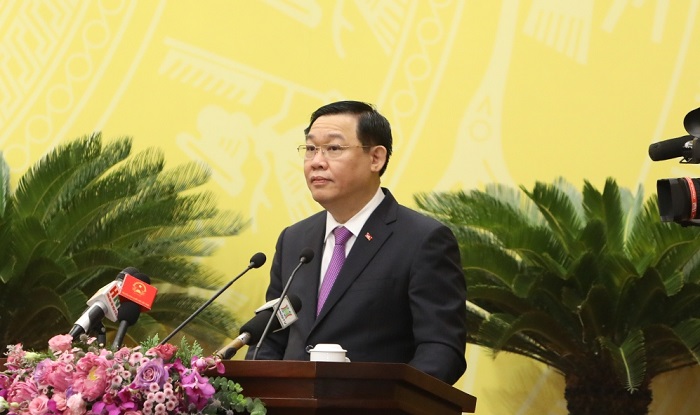Hanoi to tap into domestic market to achieve socio-economic targets for 2020
Low economic growth, high unemployment rate and low disbursement rate of public investment are among shortcomings that Hanoi should address in the coming time, said Hanoi's Party chief.
Hanoi would focus on tapping into domestic market and stabilizing macro-economic conditions to reach the highest possible socio-economic targets for 2020, including an economic expansion 1.3 times the national average, according to Vuong Dinh Hue, Secretary of the Hanoi Party Committee.
| Secretary of Hanoi Party Committee Vuong Dinh Hue. Photo: Thanh Hai. |
As the Covid-19 pandemic is causing a global economic recession, Vietnam in general and Hanoi in particular have been heavily affected, Hue said at a meeting of the municipal People’s Council on July 6.
According to Hue, Hanoi has been playing a pioneering role in the fight against Covid-19 and was considered by many countries as an example to follow.
As the city continues to pursue the dual target of both containing the pandemic and boosting economic growth, Hanoi’s gross regional domestic product (GRDP) is estimated to have expanded 3.39% in the first half of 2020, significantly higher than Vietnam's rate at 1.8%.
This is a significant result given the fact that global growth is projected at -4.9% in 2020 by the International Monetary Fund (IMF) in its latest World Economic Outlook update, 1.9 percentage points below the previous forecast.
Vietnam's services, one of the sectors hardest-hit by the Covid-19, grew 2.59% year-on-year in the January – June period, which indicate the huge efforts from tourism and industry in stimulating domestic consumption, Hue added.
Notably, the agriculture sector, which contracted 1.17% in the first quarter, bounced back with a growth rate of 3.5% in the second quarter. This has resulted in overall growth of 1.61% year-on-year in the first six months, higher than the growth rate of 1.15% recorded in the same period last year, Hue said.
Hue also noted several shortcomings that should be properly addressed in the coming time, including low economic growth; high unemployment rate; inflation risk from possible surge in food prices; low results of the Provincial Governance and Public Administration Performance (PAPI) index and the Satisfaction Index of Public Administration Services (SIPAS); low disbursement rate of public investment, among others.
Hue requested the local authorities to watch out for the possible Covid-19 resurgence during the process of economic recovery.
Based on preliminary data from the first half of 2020, Hanoi’s authorities have devised two growth scenarios for the remaining six months of the year.
In the first scenario and also the most optimistic one, Hanoi could achieve a growth rate of 5.9% in 2020, 1.3 times the nation’s optimistic growth scenario of between 4.4 and 5.2%, if growth rates in the third and fourth quarters reach 7.8% and 8.4%.
In a second scenario, Hanoi’s GRDP would expand 5.4%, 1.3 times the nation’s neutral growth scenario of 3.6 – 4.4%, if the city’s economy expands 6.9% and 7.4% in the third and fourth quarters, respectively.
In the coming time, Hue expected Hanoi to continue improving efficiency in state management and simplifying administrative procedures; boosting IT application in management; promoting digitalization and smart city development; developing shared-IT platforms and core national database, among others.












